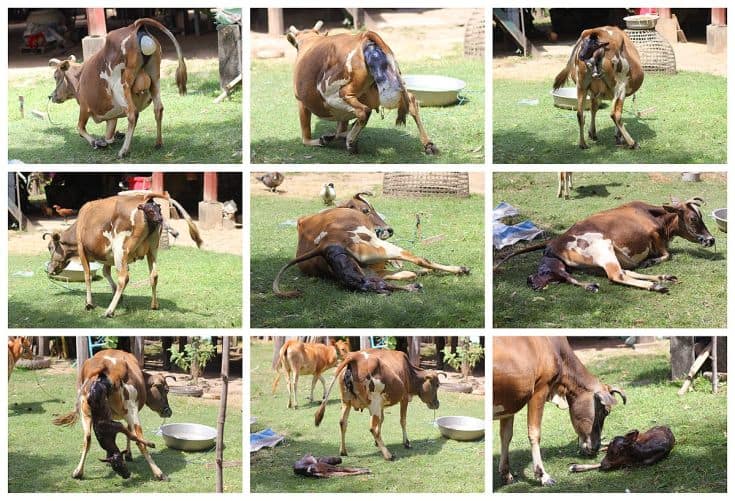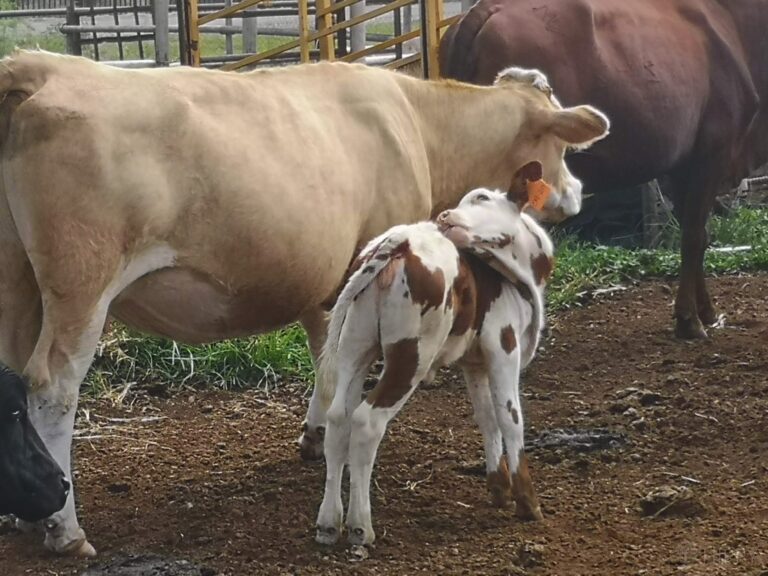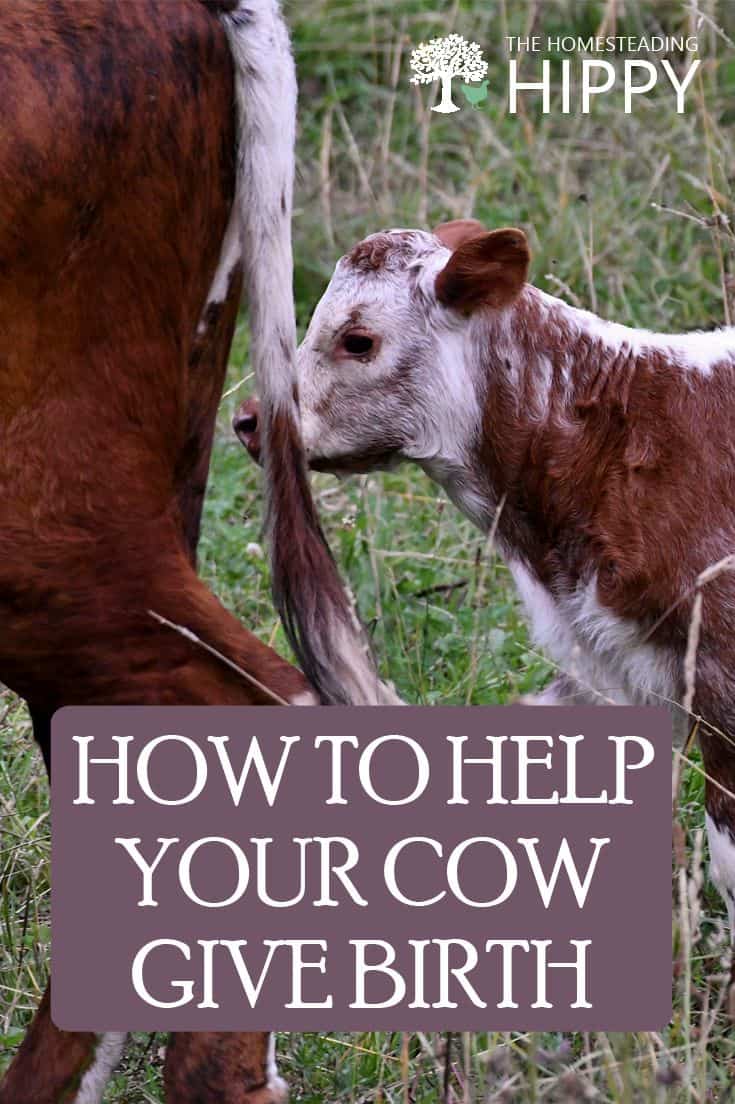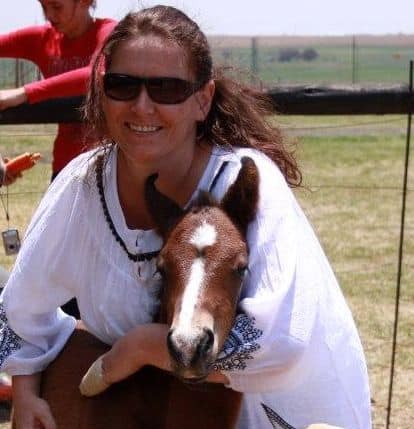Let’s face it, pregnancy, and the miracle of birth are amazing. How does one make a whole other person, calf, or anything with a heartbeat inside of themselves?
Watching that new soul come into the world is about the most emotional thing I have ever witnessed in my life.
I always wanted a natural birth; nature did not cooperate, and I needed the maximum help (caesarian sections) three times. I have had horses’ foal, cow’s calf, sheep lamb, and even chickens hatch. I have had to assist with more deliveries than you could imagine.

Being present for a birth is a wonder to behold. The problem is that human nature is often way too impatient and even anxious than needed. Nature knew what it was doing when it made you, and it knew what it was doing when your cow got pregnant.
The show is incredible to watch, especially with little kids. But kids are noisy and excitable. Make sure you keep them calm and quiet for the cow’s sake.
When it comes to birthing livestock, I believe in the two-step approach:
- Step 1: Ma’am! Step away from that mama!
- Step 2: When in doubt, call your vet!
However, there are times when the only thing you can do is to intervene and assist in the birthing of the calf. There are situations where medical intervention becomes the difference between life and death. Leaving your cow to struggle can result in the death of both the cow and or calf.
There are, however, certain things you can do to help make your cow comfortable, things you can watch to ensure things are moving along without putting mom or baby at risk, and things you can do to help delivery if absolutely needed!
Call your vet to let him or her know that your cow has begun to labor. An early warning phone call could save the lives of both the cow and the calf.
Table of Contents
What To Look For
Often, we do not track the exact date our cows are covered. This makes it hard to know exactly when the calf is due to be born. However, there are things that can indicate the cow will give birth soon.
Weather conditions, a history of difficulty giving birth, abandonment of calves after delivery, size of cow or calf and the health of the cow, all play a role in birthing.
Knowing what to look for can help you plan, pen, and closely monitor your cows progress before, during, and after the birthing delivery process ensuring a healthy cow and calf.
Essentially, you need to know signs that labor is starting, how long labor typically lasts, and how to know when your cow is in trouble and needs a little help. Here are some clues that your calf will soon be born:
- The udder will bag (drop), and will bulge with all the milk in it, leaving no wrinkles on the udder or teats. Do not milk the cow to relieve the pressure, the udder is holding valuable colostrum for the calf;
- The vulva (the opening of the birth canal) will become extended, and could even bulge out;
- There may be a mucus discharge from the vulva;
- The pelvic ligaments will relax, there will be a depression between the top of the tail and the pelvic bone;
- The cow will separate herself from the herd, spending more time alone;
- She will lie down and stand up more often as she tries to get comfortable;
- She will be clearly uncomfortable;
- Close to when your cow goes into labor, she will suddenly look thinner (as if she is not pregnant at all); this is because the calf has positioned itself for entry into the birth canal.
Stages of Labor
Labor in cows is divided into three stages:
Stage 1: Internal Preparation By The cow
In this stage, contractions begin. They are not intense; they are rather mild and spaced far apart. The cow will get up, move about, and lie down often. It will be clear that she is in some discomfort.
As things progress, contractions will become more frequent and more intense. Stage one lasts for two to six hours and ends when the fetal membrane (water bag) emerges.
During this stage, the cervix is opening, the calf is moving into the birth canal, and the cow is in active labor.
Stage 2: Delivery
This is where the magic happens…
Contractions are intense. The cow will normally lie down on her side for the delivery. The calf enters the birth canal after the fetal membranes. The front feet of the calf are normally the first part to emerge.
Don’t be alarmed and step in to help too early if the feet come out and disappear back in several times before the head comes out, this is normal.
Once the feet emerge, progress should be steady. From this point, in cows labor should last half an hour, in heifers an hour.
Stage 3: Afterbirth
Once the calf is out, contractions will continue until the placenta is delivered. The placenta is normally expelled within three to eight hours.
The cow will normally immediately clean the calf, and eat the afterbirth. This is normal, she is removing the smell of the afterbirth to protect the calf from predators who smell an easy target.
Now that you know what to expect from a normal delivery, let us see what you can do to help your cow give birth.
Setting the Moo-d
Monitoring when your cows are covered is the easy way to prepare for delivery. Pregnancy in cows normally lasts 279 to 287 days. In the days before your cow goes into labor, you will see her spending more and more time on her own.
This is normal – the men who were in the delivery room when their wives gave birth will understand this well, it is often referred to as “You did this to me!” syndrome.
She is looking for a quiet spot to work through those last uncomfortable days and a quiet spot to deliver. When you see this behavior, get some extra bedding in a stall, and move the mama in.
Try to make sure she can see and hear the rest of the herd from her labor ward, if you are a mom with teenagers you know that misery loves company, and often it is fun to tell them:
“Just you wait, one day you are going to go through this. Then we will see who has the smart mouth.”
Your cow’s calving pen should be at least 10″ x 12″, it should have plenty of bedding, be clean and dry, and free of items on which to get hurt.
Most important: give her plenty of water to drink and fodder to chew to soothe herself, and prepare for the milk rush.
Remember, cows do not like fussing. Step back and let her do her thing. If you check her too often, labor can stop.
When Rendering Assistance
Call for help
If you do find yourself in a situation where your help is needed, start by calling your vet or another local who knows a thing or two about delivering calves to get some backup rolling.
With any animal, there are things that can happen that you will have no control of.
For example, did you know that a cow weighs an average of 1000 pounds (450 kgs)! If she is standing up when you go to help and she suddenly lies or falls over you, you are not getting up in a hurry!
Hygiene
Make sure the stall is clean and free of obstacles that you or your cow could get entangled in.
Make sure you’re clean, and not wearing any jewelry or items that could go missing inside your cow. Don’t laugh, it happens more often than you think!
Prepare buckets with warm water and soap, for cleaning the cow’s vulva (and your hands if your help is needed).
Equipment
Make sure you have the correct equipment needed and that it has been sterilized. You will need:
- Buckets of warm water
- A new cake of soap (not liquid)
- Rope to tie the cow up to restrain her
- And two calving ropes or chains
Know HOW to Intervene
Before you go in there, make sure that the help you are considering is needed and that what you plan to do is appropriate to the situation in front of you.
Issues That Could Indicate Assistance Is Needed
So, when do you step up and help? How do you know that help is necessary and what do you do?
Always call your vet before you get involved. Your vet will be able to advise you whether or not to intervene, and what to do in case they cannot come to help you with the delivery.
Long Labor
As I’ve said, labor for a cow should last 30 minutes after the water membrane ruptures, while for a heifer (a first-time mom) it can last two hours.
While I don’t recommend stepping in too soon, I also don’t recommend waiting too long to assist. For a cow, I would give a maximum of one hour for a heifer 90 minutes.
If you leave the cow to strain for too long, this could result in the death of the cow and her calf. If you leave her too long and the placenta detaches while the calf is still in her, chances are the calf will die.
Incorrect Position
Most long labors occur because the calf is not in the correct position. If the calf is not in the correct position the cow will need assistance at least, but possibly even a caesarian delivery.
This is another reason to alert your vet early if you have a cow in labor. The vet will be able to try to be available and guide you through the stages.
The only real way to check delivery is to insert your ringless, watch-less hand into the birthing canal, and see what you can feel.
Once labor starts, you should check progress at least three times a day. Heifers will need to be checked more often.
You should feel the front feet and the head should be a few inches behind the feet if the calf is in the correct position.
Any abnormal position requires specialist attention.
If you feel the head, but it is bent backward, the calf is probably in breech position, and good skill is essential – and fast! This is another reason you may want to call your vet, he or she needs to plan their lives around emergency calls, and this is a big one.
Torsion can also be a problem. This is when the uterus of the cow has turned over. This is also diagnosed by reaching – ringless and watch-less. If you feel that the membrane is between you and the calf.
This can occur any time after 70 days of gestation. If torsion is about 180°, the blood supply to the calf can be cut off and this will result in fetal death. You will be able to feel this fairly easily on examination.
If you reach in and, instead of finding feet, you find a solid lump, torsion has occurred. If this does occur at any stage and the calf is not delivered or removed, the dead calf can decay and turn gangrenous which can lead to the death of the cow.
If you find yourself feeling a spongy mass, the placenta has detached, and is coming out ahead of the calf. This is a true emergency. With the placenta detached, the calf is not receiving oxygen. Immediate intervention is needed to remove the calf.
If you reach in, check the joints of the legs you find. The front legs fetlocks and knees only move in the same direction, the back fetlock and hock bend in opposite directions. The front legs should always come first. If you feel the back legs, you need your vet, the calf is coming out backward.
Birth Weight
The birth weight can also affect the birth. This is especially true in heifers (first timers). A big calf can be taxing on a new mom.
Age of Cow
With age and experience, giving birth will be easier. Cows birthing their first or second calves tend to have to work harder and need assistance more often than mature cows who have been through the process a few times.
Young cows or heifers will need to be checked regularly throughout the labor process.
How to Help a Difficult Delivery
Only step in if labor extends past the 30-minute mark for cows, and past 60 minutes for heifers. Only assist if the calf is in the correct position and the only problem is the long delivery time.
Now, if the calf is in a good position and the labor is taking too long – and you have called your vet – you can assist.
To assist your cow, you will need:
- Someone to assist you with delivery
- Clean warm water, two big buckets should do (have someone available to bring more if needed)
- Two 79″ long ¼” calving ropes
- A rope to tie her up with so that she doesn’t surprise you with any sudden movements
- A clean (new) cake of soap or lubricant – do NOT use liquid soap as this will dry the cow’s natural lubrication
Steps To Help Your Cow Give Birth
Now for the amazing appearing act! The time has passed, and it is time to step in and help.
Please note this is NOT a one-person job. Cows are bigger and heavier than people. One person pulling on calving ropes is not likely to have much success and it is dangerous to help on your own.
- Secure the cow safely so that she cannot bolt or turn around suddenly.
- Thoroughly clean her vulva using soap and water.
- Remove all jewelry up to your shoulder.
- Wash your hands in clean water using soap, all the way to your shoulders.
- You can use the cake of soap with some warm water or (for preference) if possible, use proper lubrication inside the cow if needed.
- Locate each of the calf’s front legs and attach a calving rope to each leg above the second joint.
- Alternate pulling down on one leg and then the other. Use the cow’s contractions so that you are assisting her rather than just pulling the baby out on your own.
- If you still cannot get the calf out, you will definitely need your vet to come out to deliver the baby as soon as possible – don’t wait too long!
Calf Resuscitation
Sadly, many long deliveries result in fetal death. There is a chance that the calf can be revived if you have taken swift, appropriate action.
Once the calf is out clear the airway, make sure nothing is wrapped around any part of the calf.
Stimulate the calf to breathe by tickling the inside of its nose with some hay, by rubbing it briskly, or by slapping it a few times.
If the calf is not breathing, use a hose to provide artificial respiration. Place a small section of hose in one nostril.
Hold the mouth and both nostrils shut, and give a deep breath into the hose. Let the calf expel the air and repeat at five-second intervals until the calf begins to breathe on its own.

Post Delivery Care
Often after long hard labors, some cows will abandon their calves. It helps if they are penned. This way, as the mother recovers, she will bond with and care for the calf.
The cow will need a lot of fodder and water to boost her milk production. Make sure she has plenty of food and water available, and that her stall is clean and dry.
There are two main concerns that you will need to watch out for post-delivery that could have tragic consequences for your cow if left untreated.
The first is uterine prolapse. This normally can occur when the calf is pulled out too quickly forming a partial vacuum that causes an inversion of the uterus. Get your cow up and moving as quickly as possible after delivery, and call your vet for immediate treatment.
The second is a retained placenta. The placenta should be expelled within two to eight hours after delivery. If the placenta does not detach and the cow does not expel it, you will need medical assistance.
Leaving it inside the cow could result in illness, and the cow could be rendered sterile. Your vet may remove it – do not try to remove it yourself, you could do more harm than good.
Or he or she may provide antibiotics – this also carries some risk as it has a residue which the calf cannot ingest which means you will have to provide milk substitute for the calf.
It is important that the calf drink well before administering antibiotics, so it can get all the healthy colostrum mom has been producing and collecting in her udder over the last few months, as this will give the calf’s immune system a healthy boost.
You have roughly eight hours from birth before treatment is needed. The calf only needs milk or milk substitute for the first twelve weeks.
They will start grazing with their mom within days after delivery, but they do not need any special feed as long as they are consuming roughly 10% of their body weight.
Summary
I hope that you have learned a lot from this article. Nothing is more valuable when it comes to life than good hands-on learning. If you have never been present for an assisted or normal delivery, you should never try it on your own.
Get your plans ready ahead of time. Make sure you have everything that may be needed by yourself (and the vet) ahead of time.
Pregnancy in cows last for roughly nine months. If you know exactly when the cow was covered, you can track the rough due date and prepare accordingly. If you don’t know when she was impregnated, you will have to work off the signs that delivery is imminent.
Monitor all your cows carefully during the calving season or as their due dates come closer.
Prepare the area where your cow and her calf will be for the delivery. There is nothing wrong with calving in a meadow for a normal delivery.
But try to pen the area off so that you can monitor the labor and delivery, and also to ensure that the cow does not have much room to abandon the calf, so that the calf will be able to find her and feed.
While mom is pregnant, try to attend as many births in your area as possible to learn how to tell if labor is starting or will start soon, what is normal, how to check the cow, what indicators show that she’ll need help, when to step in to help, and most importantly, how to help the cow deliver a healthy calf and recover from the birth.
And ma’am, step away from that cow! And go call your vet!
Let us know how it goes with your cow’s delivery in the comments section below. We love hearing back from our readers. And don’t forget to pin this for later!


Di-Anne Devenish Seebregts was raised in an environment where daily life consisted of hiking, environmental conservation, growing fruit and vegetables, and raising poultry for meat and eggs.
She combined her passion for the writing word with her love of the pride that comes with not relying on others. She raised three children (who are now adults) to value the environment, and understand the value of being self-sufficient.
Find out more about Di-Anne on our About Us page.
